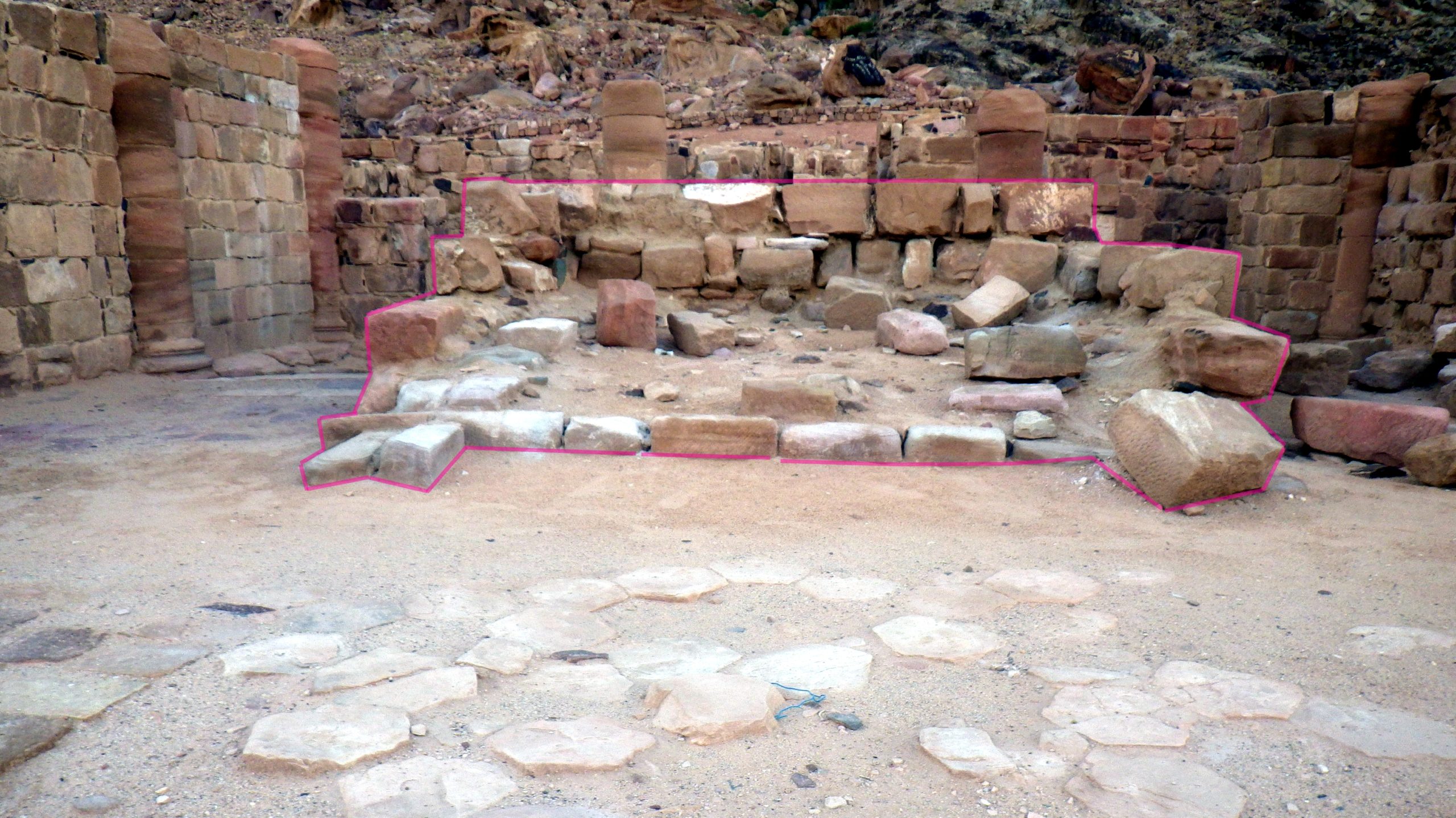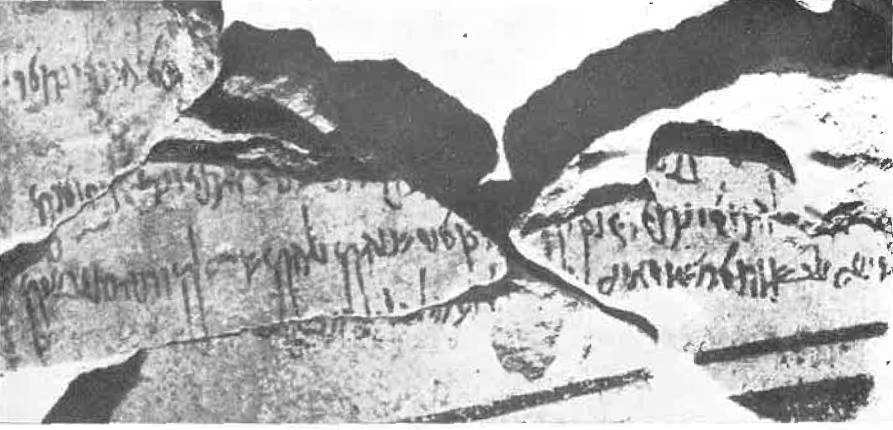Temple to Allat at Wadi Ramm
 Temple to Allat at Wadi Ramm
Temple to Allat at Wadi RammClick on Image for high resolution magnifiable image
photo by Jefferson Williams
| Transliterated Name | Language | Name |
|---|---|---|
| Er-Ram | Nabatean | |
| Iram | Nabatean | |
| Jebel er-Ram | Arabic | جيبيل يرءرام |
Er-Ram in Wadi Ramm is not described in any extant texts and what little we know about it comes from
inscriptions found on the site. These inscriptions indicate that the Temple was dedicated to the pre-Islamic Arabian Goddess
Allat. (Avraham Negev in Stern et al, 1993 v. 4)
Er-Ram is the site of a Nabatean temple in Jordan, about 40 km (25 mi.) east of 'Aqaba (map reference 190.887). The ancient name of the place is preserved in the Arabic name Jebel er-Ram. In the Nabatean inscriptions (see below) uncovered in the ruins of the temple and in the small shrine of Allat, near the spring of 'Ein esh-Shellaleh at the foot of the mountain, the name of the place appears as "Iram."
The history of the site is not recorded in any source and is known only from the epigraphic material found here. The dating is based on two Nabatean inscriptions found at the site, one in the ruins of the temple and the other at the spring of 'Ein esh-Shellaleh. The first contains a fragment of a date: "And this is written on the day/ ... of Ab in the year 40 and ... ," from which one of two alternatives can be inferred: the inscription refers to the forty-first or forty fifth regnal year of Aretas IV, the only Nabatean king to rule for more than forty years - so that the date of the inscription is 31 or 36 CE; or the date is given according to the era of the Provincia Arabia, which would make it the year 147 or 151 CE. The excavators found no mention of Aretas IV's surname (Philodemos) in the inscription and hence were more inclined to accept the second date. The other Nabatean inscription, found in the ruins of the shrine of Allat at 'Ein esh-Shellaleh, has been quite definitely assigned to the reign of Rabbel II (70-106 CE). Because the king's two wives are mentioned, it is assumed that the inscription belongs to the later years of his reign. A third inscription, carved on the base of an altar in the ruins of the temple, is in Latin. It appears to mention the name of Emperor Caracalla (211-217 CE), and belongs not to the temple itself, but to a later period.
It is difficult to accept the opinion of the excavators that the temple was built in the first half of the second century CE. All the Nabatean temples in Hauran (such as the temples at Seeia), in Transjordan (et-Tannur), and in the Negev (Oboda) were built on the same plan either toward the end of the reign of Obodas III or during the reign of Aretas IV, the great period of Nabatean prosperity. It seems, therefore, that the temple at er-Ram, which was erected near the main Nabatean caravan route from Arabia to Transjordan, was also built in the days of Aretas IV, and the date in the inscriptions found in the temple is to be interpreted accordingly. This view is corroborated by the typical Nabatean pottery found in the temple area, which at Oboda was assigned to the first half of the first century CE.
In the days of Rabbel II, the water from three or four of the eleven springs near 'Ein esh-Shellaleh was brought through canals to a large reservoir. Excavations at Nabatean Oboda have also yielded information about the water installations constructed in the reign of Rabbel II. A Nabatean military camp apparently was also built in that period near 'Ein esh-Shellaleh.
The shrine of Allat was discovered by G. Horsfield in 1931. About a year later, the site was surveyed by R. Savignac, who found many Nabatean and Greek graffiti. During a survey of Jebel er-Ram in the same year (1932), the remains of a temple were discovered. In 1934, the site was excavated under the direction of Horsfield and Savignac on behalf of the Ecole Biblique et Archeologique Francaise in Jerusalem and the Jordan Department of Antiquities. In 1959, excavations were undertaken by D. Kirkbride, on behalf of the British School of Archaeology in Jerusalem, in conjunction with the Jordan Department of Antiquities.
- Temple Plan from
Stern et al (2008)

 Er-Ram: plan of the tNabataean temple
Er-Ram: plan of the tNabataean temple
Stern et al (2008) - Temple Plan after Horsfield
and Savignac from Stern et al (1993 v. 4)

 Er-Ram: plan of the temple, after Horsfield and Savignac
Er-Ram: plan of the temple, after Horsfield and Savignac
Stern et al (1993 v. 4 - Temple Plan after Kirkbride
from Stern et al (1993 v. 4)

 Er-Ram: plan of the temple, after Kirkbride
Er-Ram: plan of the temple, after Kirkbride
Stern et al (1993 v. 4
- Temple Plan from
Stern et al (2008)

 Er-Ram: plan of the tNabataean temple
Er-Ram: plan of the tNabataean temple
Stern et al (2008) - Temple Plan after Horsfield
and Savignac from Stern et al (1993 v. 4)

 Er-Ram: plan of the temple, after Horsfield and Savignac
Er-Ram: plan of the temple, after Horsfield and Savignac
Stern et al (1993 v. 4 - Temple Plan after Kirkbride
from Stern et al (1993 v. 4)

 Er-Ram: plan of the temple, after Kirkbride
Er-Ram: plan of the temple, after Kirkbride
Stern et al (1993 v. 4
 Inscription from Temple to Allat
Inscription from Temple to Allat
They key seismic discovery at the Temple to Allat is a Thamudic inscription discovered at the ruins on the site. The inscription may have been placed after the site was rebuilt due to earthquake damage. This may reflect be a pattern during this time when the Nabateans rebuilt their temples (e.g., The High Places at Petra, Khirbet Tannur, and the Temple to Allat in Wadi Ramm) soon after earthquakes damaged them. The inscription contains a fragment of a date:
and this is written on the day/ . . . of Ab in the year 40 and . . . ,. 'Two alternatives were proposed for dating this inscription (Avi-Yonah, 1975)
- The inscription refers to the 41st or 45th year in the reign of Aretas IV; the only Nabatean King who ruled for more than 40 years (he ruled for 49 years - from 9 BCE – 40 CE). This would place the date of the inscription in ~32 or ~36 CE. If all the years between his 41st and 49th regnal years are considered, the inscription would date from ~32 – ~40 CE. No explicit reason was given why only the 41st and 45th years were considered.
- The date specifies the era of the Provincia Arabia which would date the inscription as follows:
Again, no explicit reason was given why only the 41st and 45th years were considered. The full date range for the 41st to 49th years of Provincia Arabia is from 22 March 146 to 21 March 155 CE.Year of Province Arabia Date Range Comments 41 22 March 146 to 21 March 147 CE Calculated using CHRONOS 45 22 March 150 to 21 March 151 CE Calculated using CHRONOS
Avi-Yonah, M. (1975). The Encyclopedia of Archaeological Excavations in the Holy Land Vol. IV, Israel Exploration Society and Massada Press
Kirkbride, D. (1960). "Le Temple Nabatéen de Ramm: Son Évolution Architecturale." Revue biblique 67: 65-92.
Savignac, R. (1932). "Le Sanctuaire d'Allat à Iram (Part 1)." Revue biblique 41: 585-594.
Savignac, R. (1933). "Le Sanctuaire d'Allat à Iram (Part 2)." Revue biblique 42: 405-422.
Savignac, R. (1934). "Le Sanctuaire d'Allat à Iram (Part 3)." Revue biblique 43: 572-589.
Savignac, R. and Horsfield, G. (1935). "Le Temple de Ramm." Revue biblique 44: 245-278.
Tholbecq, L. (1998). "The Nabataeo-Roman Site of Wadi Ramm (Iram): A New Appraisal." ADAJ 42: 241-254.
R. Savignac, RB 41 (1932), 581-597; 42 (1933), 405-422
43 (1934), 572-589
(with G. Horsfield) 44
(1935), 245-278
G. Ryckmans, ibid., 590-591
H. Grimme, ibid. 45 (1936), 90-95
A. S. Kirkbride (and
G. L. Harding), PEQ 79 (1947), 7-26
D. Kirkbride, RB67 (1960), 65-92
id.,JLN(Aug. 13, 1960), 262-
263
J. Strugnell, BASOR !56 (1959), 29-36
J. T. Milik and J. Teixidor, ibid. 163 (1961), 22-25;
N. Glueck, Deities and Dolphins, New York 1965, passim
J. Patrich, IEJ34 (1984), 39-46
J. A. Bellamy,
JAOS 108 (1988), 369-378.
N. P. S. Price and A. N. Garrard, ADAJ 20 (1975), 91-93.
H. -D. Bienert, OJA 9 (1990), 257–261
S. Fares-Drappeau, ADAJ 39 (1995), 493–498
45 (2001), 205–216
(with F. Zayadine)
id., AJA 101 (1997), 496–497
id. (& R. Zayadine), MdB 109 (1998), 85
J. P. Oleson,
SHAJ 5 (1995), 707–719 (p. 713)
D. Dudley & B. Reeves, ACOR Newsletter 8/1 (1996), 7
9/1 (1997), 9–10;
id., Echos du Monde Classique 41/16 (1997), 81–106
id., AJA 102 (1998), 591–592
L. Tholberq, MdB
103 (1997), 55
id., ADAJ 42 (1998), 241–254
id., AJA 102 (1998), 592–593
B. Reeves, ASOR Newsletter
48/1 (1998), 27–28
R. Zayadine & S. Fares-Drappeau, ADAJ 42 (1998), 255–258
E. Bloch-Smith, IEJ 54
(2004), 77–91
D. O. Henry, Mitekufat Ha’even 35 (2005), 353–370.
